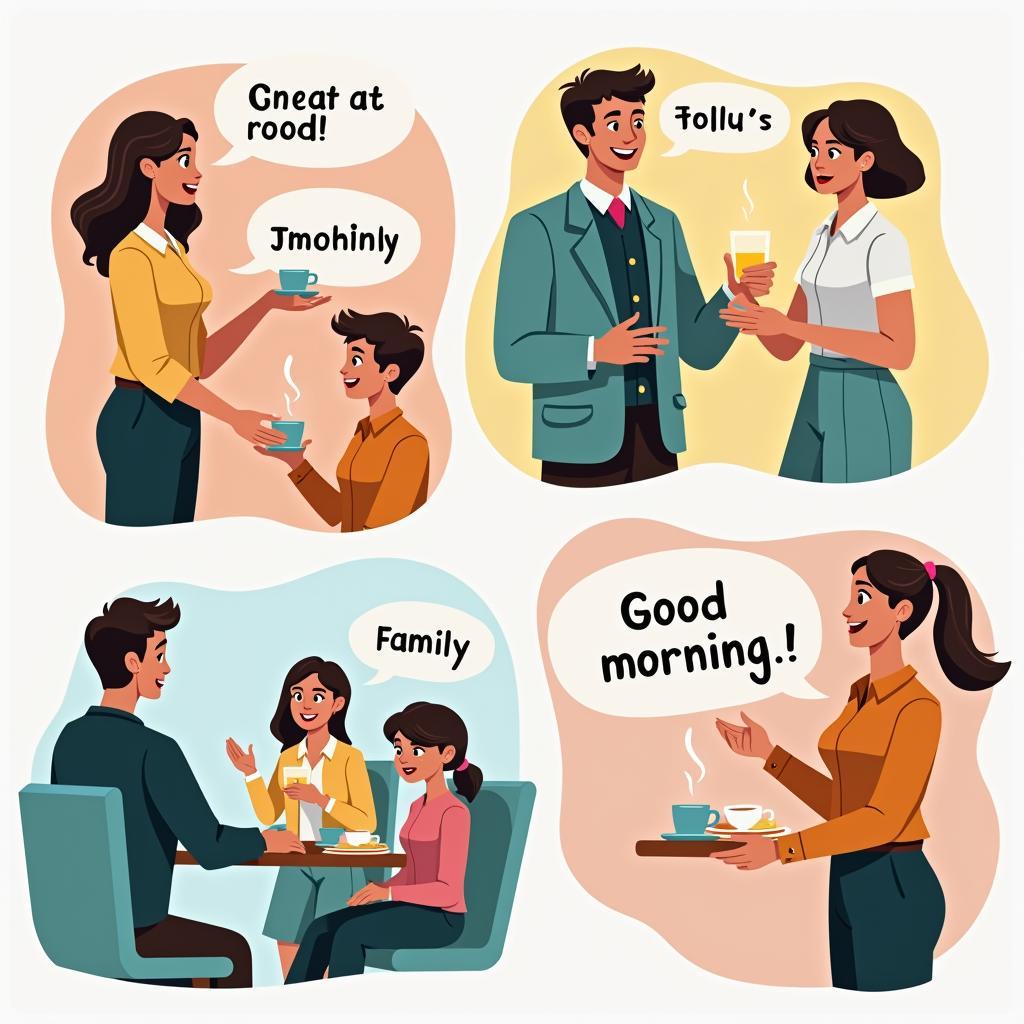
Good morning in English is a simple yet powerful phrase, used daily by millions around the globe. From casual conversations to formal settings, knowing how to say good morning and its variations can significantly enhance your communication skills. This guide dives deep into the nuances of this common greeting, providing valuable insights for learners of all levels.  Various ways to say good morning in English
Various ways to say good morning in English
Different Ways to Say “Good Morning”
While “good morning” is the standard greeting, the English language offers a delightful array of alternatives. These variations add color and personality to your interactions.
- Good day: A slightly more formal option, suitable for professional settings or when addressing someone you don’t know well.
- Morning!: A shorter, more informal version of “good morning,” commonly used among friends and family.
- Rise and shine!: A cheerful and energetic way to greet someone, especially in the morning.
- Top of the morning to you!: A traditional Irish greeting, adding a touch of cultural flair.
These are just a few examples; exploring different options will enrich your vocabulary and communication style. Did you know that expressing joy can brighten your morning and even your entire day? Check out our article on 20 điều để sống vui vẻ for more tips on cultivating happiness.
When to Say “Good Morning”
“Good morning” is typically used from sunrise until noon. However, the exact timeframe can vary depending on cultural context and personal preference.
Using “Good Morning” in Different Situations
The appropriateness of “Good Morning” also depends on the situation.
- Formal settings: In professional environments, using “good morning” or “good day” is generally recommended.
- Informal settings: With friends and family, more casual greetings like “morning!” or “rise and shine!” are perfectly acceptable.
- Written communication: In emails or letters, “good morning” is a polite and professional way to begin.
 Examples of using "good morning" in various settings
Examples of using "good morning" in various settings
Responding to “Good Morning”
Responding to “good morning” is equally important. A simple “good morning” back is usually sufficient. You can also add a pleasant “How are you?” to show further engagement. For more heartfelt expressions, you can explore our bài thơ niềm vui.
Beyond the Basics: Adding Personal Touches
To make your greetings more personal, consider adding a comment about the weather or a shared experience. For example, “Good morning! What a beautiful day!” or “Good morning! Ready for that meeting?”
Adding these small touches can make your interactions more meaningful and memorable. Sometimes, even a simple gesture or act of kindness can turn an ordinary day into a celebration. Read more about organizing a joyous event in our article on tổ chức vui trung thu cho các em.
Common Mistakes to Avoid
While “good morning” seems straightforward, some common mistakes can be easily avoided.
- Using “good morning” in the afternoon or evening: This is a common error. Use “good afternoon” or “good evening” instead.
- Overusing informal greetings in formal settings: Stick to “good morning” or “good day” in professional environments.
- Forgetting to respond: Always acknowledge a “good morning” greeting, even with a simple nod or smile.
“Learning how to properly greet someone can make a huge difference in building positive relationships,” says Emily Carter, a renowned communications expert. “It shows respect and sets the tone for a productive interaction.”
Conclusion
Mastering the art of saying “good morning” in English is more than just learning a phrase; it’s about building connections and navigating social situations effectively. By understanding the nuances and variations, you can enhance your communication skills and leave a positive impression. Remember, a cheerful “good morning” can brighten someone’s day and create a welcoming atmosphere. So, embrace the power of this simple greeting and spread some positivity! A good laugh can also do wonders. Find some humorous anecdotes in our article on chuyện vui ngày 20 11. If you’re looking for a relaxing and enjoyable stay, check out xóm vui homestay.
FAQ
- What is the most formal way to say “good morning”?
- Can I use “morning” in a business email?
- What is the appropriate time to say “good morning”?
- How do I respond to “good morning”?
- What are some other ways to greet someone in the morning?
- Is “top of the morning to you” considered formal?
- How can I make my “good morning” greetings more personal?
Khi cần hỗ trợ hãy liên hệ Số Điện Thoại: 02543731115, Email: [email protected] Hoặc đến địa chỉ: G55W+PWG, 686 Đ. Võ Văn Kiệt, Long Tâm, Bà Rịa, Bà Rịa – Vũng Tàu 790000, Việt Nam. Chúng tôi có đội ngũ chăm sóc khách hàng 24/7.